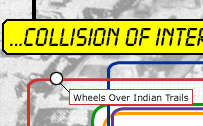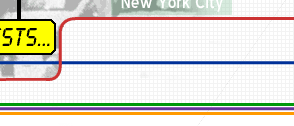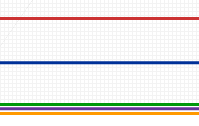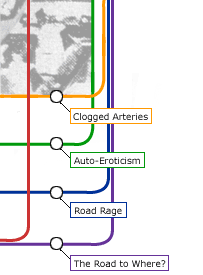



In-Line Skating in Everyday Manhattan Life || Towards a Pedestrian Agenda
Personalizing Public Transportation
By Thomas H. Floyd, Jr.
From The Futurist
Transportation is vital to urban life, but the means now used to move around within communities cause many serious problems. Fossil-fueled cars, trucks, and even buses produce poisonous air, harmful noise, increased soil salinity, toxic wastes, overdependence on imported petroleum, and (for cars) high injury and death rates. Their roadway, track, stations, and parking consume too much paved land and disrupt communities and businesses excessively during construction. Moreover, the present means of urban transportation have neglected the needs of nondrivers as well as the poorer residents of cities and suburbs. The overall quality of service, especially that offered by public transportation, is too often substandard.
Auto emissions also contribute to global warming. And cars create mammoth traffic jams, so that people now spend more time travelling to and from work than they spend playing with their children.
There is a way out of these problems: a new, "personal" kind of public transportation that will help restore balance to urban transportation. This system would consist of a finely woven network of personal rapid transit (PRT) stations and track that would offer appealing and economical service for nondrivers. As the PRT network expanded, a growing number of automobile users would opt to use it.
Why Transit Now Fails
Urban areas are no longer compact, high-density areas, but have spread out into the countryside. Destinations are farther apart and trips take longer. People no longer go primarily to and from the center of the city. The majority of trips now are crosstown and between suburbs, flowing into and around the growing number of activity clusters that challenge the center city for supremacy.
As a result, there has been a steady decline in the use of mass-transit systems that were developed to serve high-density urban cores. "Mass" transit, as the name suggests, was based on the principle of large vehicles picking up the masses of walkers who once thronged tightly packed cities, carrying them to and from work and businesses in the dense central area. The idea was brilliant when conceived, but it can't compete with automobiles in "spread-city." Today, less than 3% of all trips made in U.S. urban areas are made on public or mass-transit facilities.
Customizing Transit
Inventive minds in the 1950s began to conceive of a type of public transportation that might compete better with the automobile. One of the pioneers was Donn Fichter, who published a seminal book in 1964, entitled Individualized Automatic Transit and the City. His and similar ideas coalesced around the name "personal rapid transit" in the 1970s, emphasizing the essential features of all true PRT systems. These are:
Fully automated vehicles (i.e., without human drivers)Vehicles captive to the guideway, which is reserved for these vehicles
Small vehicles available for exclusive use by an individual or a small group travelling together by choice, and, if desired by the owner and operator, available for service 24 hours a day (i.e., "personal" and not "mass" service)
Small guideways that can be located above ground, at or near ground level, or underground
Vehicles able to use all guideways and stations on a fully connected network
Direct origin-to-destination service, without requiring transfer or stop at intervening stations
Service available on demand rather than on a fixed schedule
These features have some extremely important implications. First and perhaps most important, they imply a public-transportation service that would have many of the appealing characteristics of the automobile. You could, for example, ride alone or only with passengers of your choice. You could board a vehicle as soon as you arrived, or after a brief wait, in a small, well-lighted station. You could travel nonstop from your boarding station to your selected destination without delays at intervening stations - a service even better than the automobile provides.
The top speed of PRT vehicles would often be much lower than the top speed of either automobiles or traditional mass-transit vehicles, but average operating speeds would be much higher since PRTs would not be deterred by traffic jams and frequent stops. PRT vehicles running nonstop on the main line from origin to destination could achieve average operating speeds of 30mph or better, compared with 20mph or less for automobiles and transit vehicles in urban rush-hour traffic.
PRT would not always offer the front-door availability of an automobile, but its relatively inexpensive track and stations could be densely spaced in a fine network. As a result, walks to stations should rarely exceed a few minutes. Stations in activity concentrations, such as shopping malls, hospitals, or other service centers, could have direct connections into buildings. Stations could also connect directly to large apartment buildings or complexes.
Mass transit on track, relying on large road vehicles, is too expensive to build with such a tight network and many stations. Its costs limit it to a few heavily traveled corridors with large stations spaced relatively far apart. This is the fundamental reason rail transit is unable to compete well with the automobile in the suburbs, except for specialized commuter service to the city center.
PRT, on the other hand, is based on small and light guideways and stations. This allows many more stations to be deployed for the same or less capital; and, as more are needed, guideways and stations can be added into the growing network. Like roadway or telephone systems, the PRT net could continually expand to serve new and greater needs. Even closer station spacing might become justified economically as population density increases in some areas, reducing maximum walk time to a couple of minutes.
Mass transit based on large vehicles such as buses suffers not from high track costs, for it shares the roadway with cars, but from its intensive labor costs, which represent a high proportion of total cost. Each bus requires a driver. Buses running nearly empty, as they often do running between the peak hours, are major money losers for operators and taxpayers. Even with large tax subsidies, no transit operator can long afford to offer frequent bus service during middays, evenings, nights, or weekends. Those riders who most suffer from this poorer quality of service are the low-income workers, poor on welfare, and elderly and handicapped nondrivers who have no other choice. The community suffers, too, because few auto users desire to switch to buses.
PRT costs little extra to operate during the off-peak hours. Cars rest in stations when not in demand or being redistributed. Each additional rider attracted to the service during these times, moreover, generates a financial benefit.
Pioneering the PRT Future
Recognizing these potential advantages of personal rapid transit, the Regional Transportation Authority of Chicago announced on April 24, 1990, a bold program to evaluate PRT for the Chicago area. This is the first such PRT evaluation program in the United States, which raises the interesting question of why it has taken so long for a good idea to reach this point.
One answer to this question is that some transportation professionals have resisted PRT from the beginning because it challenged existing notions of what mass transit is all about. Another answer is that satisfactory PRT designs took a long time to evolve. Early concepts contained enough deficiencies to make them easy targets of critics, who nearly succeeded in killing all PRT development programs. Finally, though, rapid advances in the underlying technologies have created more favorable prospects for PRT today than in earlier years. There have been major inventions and innovations, for example, in microprocessors, motors, and drives - all of great importance in developing PRT.
PRT development was undertaken during the 1960s and 1970s in several countries, but a system was never brought to fruition. Overcoming the complex variety of technical, environmental, safety, economic, and political handicaps proved more difficult than at first recognized.
The largest financial investment was made by the West German government in the 1970s on the system called Cabinetaxi. The system completed its test-track check-outs successfully, but for budgetary and other reasons, Cabinetaxi never received the urban demonstration that was planned for it in Hamburg.
In the United States, one of the leading designers and developers of PRT is J. Edward Anderson, whose company, Taxi 2000 Corporation, has been a vigorous advocate of PRT. The corporation, based in Revere, Massachusetts, was organized to develop PRT and assist communities and corporations in studying their transportation problems, with an aim toward installing Taxi 2000 systems.
The Advanced Transit Association (ATRA) has been the only public-interest organization dedicated since the mid-1970s to promoting research and development into PRT. A report by ATRA, published in 1989, concluded that what PRT most needs today is for transit operators, governmental authorities, and industry to begin to take it seriously. Technical issues should no longer be regarded as the predominant concerns they were once felt to be.
The report reached several conclusions about PRT's potential:
Research and development on PRT during nearly four decades demonstrate that PRT systems could now be built with state-of-the-art and off-the-shelf components.Even though a market-ready PRT system does not yet exist, one could be built and tested thoroughly at a test facility within a relatively short time and will likely perform as claimed.
PRTs can probably be built for unusually low costs compared with traditional mass-transit tracked systems. Current cost estimates for PRT, based on serious design efforts to minimize costs, appear to rely on competent and thorough analysis as well as quotations of many important components by potential suppliers.
If PRT costs -- capital and operating -- prove to be as low as now predicted, a significant advance will have occurred in the potential cost-effectiveness of transit. Assuming that PRT will attract riders better than mass transit, its revenues and bottom-line profitability should be much higher.
PRT systems, feeding to and collecting from the traditional mass-transit stations already in place, will enhance both the service and the economics of the traditional systems as well as help provide a total transit service of higher quality for lower cost.
PRT should help reduce air pollution and bring other environmental benefits to urban areas if it fulfills its promise in helping reduce auto use. Some people, however, may find its above-ground guideways and station objectionable. Much attention has been given to the design and artistic features of PRT systems to make them attractive - or at least as unobtrusive - as possible. The PRT systems envisioned are small compared with mist above-ground structures, including mass-transit track and stations. The track of the Taxi 2000 PRT system, for example, is only three feet wide - not even as wide as the vehicle that runs on it.
Where PRT systems are designed and built into new developments, there should be no problem with visual intrusiveness. If anything, PRT structures should represent assets to new developments. Only experience, including observations at the first test and demonstration sites, will reveal the public's reaction to PRT structures that are retrofitted into existing commercial and residential areas.
Hopes for Better Urban Transportation
Transit is an essential part of urban transportation. Automobiles cannot do the job alone. We will need even more and better transit in the future to reduce automobile use, both for the protection of the environment and economic welfare and to offer nondrivers and others an appealing alternative to the automobile.
Traditional mass transit cannot economically provide the kind of better transit that communities need, even though it offers valuable -- even crucial -- service in a few niche markets. The reasons are apparent: Some types of mass transit, such as rail, cost so much to build that their stations can rarely be closely spaced except in densely populated corridors. Other types of mass transit, such as buses, have such high labor costs that they cannot be run at frequent intervals (or even at all) during the off-peak or evening and night hours. If service is provided, riders must usually wait for long times in unsafe or uncomfortable conditions. And both subways and buses stop frequently so other passengers can get on and off, thus causing delays for the majority of passengers. Riders are often crowded together and must sit or stand beside anyone boarding the vehicle, regardless of personal preference.
Some newer forms of mass transit, such as the automated people movers, are helping transit give better service, sometimes more economically than traditional systems. These forms, however, serve only limited needs in special circumstances and will probably continue to be so constrained.
Unfortunately, better options are not being developed rapidly for urban transportation options with potential for widespread and economical deployment. Only personal rapid transit has this promise.
Back to top